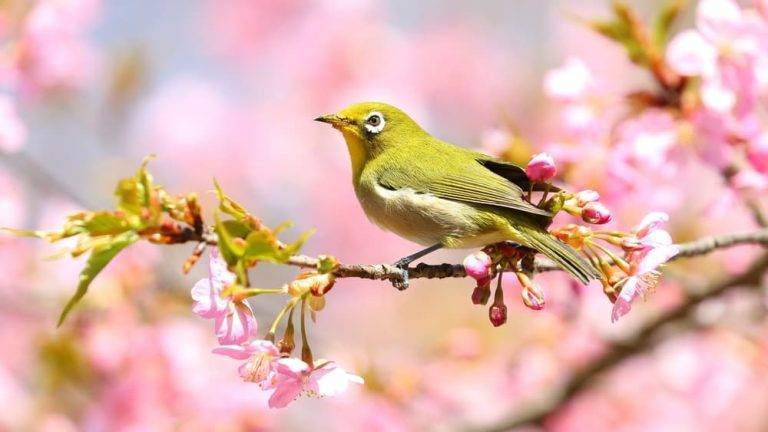The Japanese White-Eye bird, scientifically known as Zosterops japonicus, is a charming and captivating species that has captured the hearts of many bird enthusiasts. With its vibrant plumage, endearing appearance, and sweet melodic songs, this small passerine bird has become a beloved icon in Japan and beyond.
In this article, we will delve into the world of the Japanese White-Eye, exploring its physical characteristics, habitat, behavior, cultural significance, and more.
So, let’s embark on this delightful journey and discover the wonders of the Japanese White-Eye bird.
Physical Description
Habitat and Distribution
Behavior and Diet
With its lively and energetic nature, the Japanese White-Eye is a joy to observe. It is highly social and often seen in small flocks, flitting among the foliage in search of food. Its diet mainly consists of nectar, fruits, insects, and small spiders. Equipped with a brush-tipped tongue, it skillfully extracts nectar from flowers, making it an important pollinator. This bird’s acrobatic feeding maneuvers and its swift flight add to its allure and make it a fascinating subject for birdwatchers.
Breeding and Reproduction
The breeding season for the Japanese White-Eye typically occurs from spring to summer. During this time, the male engages in courtship displays to attract a female mate. These displays involve fluttering flights, calling, and showcasing their vibrant plumage. Once a pair has formed, they proceed to build a cup-shaped nest using a combination of soft plant materials, such as grass, moss, and spider silk. The female takes on the primary responsibility of incubating the eggs while the male assists by providing food. After a few weeks, the eggs hatch, giving birth to adorable and helpless chicks.
Vocalization and Communication
One of the distinguishing features of the Japanese White-Eye is its enchanting vocal repertoire. Its songs are melodious, comprising a series of clear, high-pitched notes that can be heard throughout its habitat. These songs serve multiple purposes, including territory defense, communication among flock members, and courtship displays. The birds also use various calls to convey messages and warnings, enhancing their social cohesion and survival in the wild.
Cultural Significance
In Japanese culture, the Japanese White-Eye holds a special place. Known as “Mejiro” in Japanese, it has been celebrated for centuries in art, literature, and folklore. Its presence in gardens and parks is considered auspicious, symbolizing good luck, prosperity, and the arrival of spring. Artists and poets have immortalized this delightful bird in their creations, capturing its beauty and charm. The Japanese White-Eye’s popularity has also led to the development of birdwatching tourism, attracting both locals and international visitors.
Conservation Status
While the Japanese White-Eye is not currently endangered, it faces certain threats to its population. Loss of habitat due to urbanization, deforestation, and agriculture expansion poses a significant risk. Additionally, invasive species and the illegal pet trade can disrupt local populations. Conservation efforts are in place to protect this beloved bird, including the preservation of its natural habitats, raising awareness, and implementing measures to control invasive species.
Interaction with Humans
The Japanese White-Eye has managed to coexist harmoniously with humans, even in urban areas. Its adaptability and ability to thrive in gardens and parks have made it a frequent visitor to backyard feeders, delighting both young and old with its vibrant presence. Birdwatchers and nature enthusiasts are drawn to its beauty and charming behavior, making it a popular subject for photography and observation. The Japanese White-Eye’s presence brings a touch of nature and joy to the lives of those who appreciate its unique qualities.
FAQs About the Japanese White-Eye Bird
Q: What is the scientific name of the Japanese White-Eye bird?
A: The scientific name of the Japanese White-Eye bird is Zosterops japonicus.
Q: Where is the Japanese White-Eye bird found?
A: The Japanese White-Eye bird is native to the Japanese archipelago, primarily found in regions like Honshu, Kyushu, and Shikoku.
Q: What does the Japanese White-Eye bird eat?
A: The Japanese White-Eye bird’s diet mainly consists of nectar, fruits, insects, and small spiders.
Q: Why is the Japanese White-Eye bird culturally significant in Japan?
A: The Japanese White-Eye bird, known as “Mejiro” in Japanese, is considered a symbol of good luck, prosperity, and the arrival of spring. It has been celebrated in art, literature, and folklore for centuries.
Q: Is the Japanese White-Eye bird endangered?
A: Currently, the Japanese White-Eye bird is not considered endangered, but it faces threats due to habitat loss and other factors. Conservation efforts are in place to protect its population.
The Japanese White-Eye bird, with its adorable appearance, melodious songs, and cultural significance, continues to capture the hearts of people around the world. Its vibrant plumage and lively behavior make it a delightful sight in gardens, parks, and woodlands. As we appreciate the beauty of this avian species, let us also recognize the importance of conserving its natural habitats and promoting responsible interactions to ensure its continued existence for generations to come.



